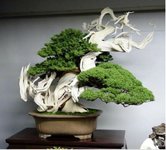Tntthunder
Yamadori
I keep seeing Junipers like these and they look absolutely beautiful.
First how do they make the trunks on Junipers so thick? All the ones I tend to see at nurseries are small and thin.
Secondly what is all the dead wood called? How is it created? Is that old parts of the tree or have they grown the tree into a dead tree?
First how do they make the trunks on Junipers so thick? All the ones I tend to see at nurseries are small and thin.
Secondly what is all the dead wood called? How is it created? Is that old parts of the tree or have they grown the tree into a dead tree?


